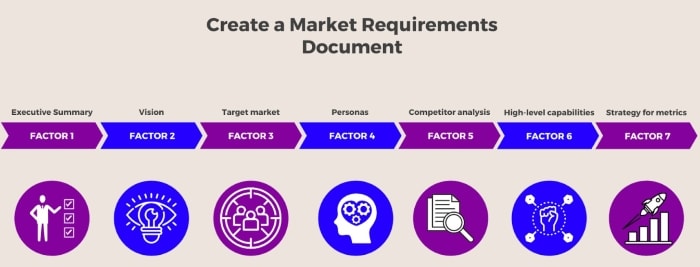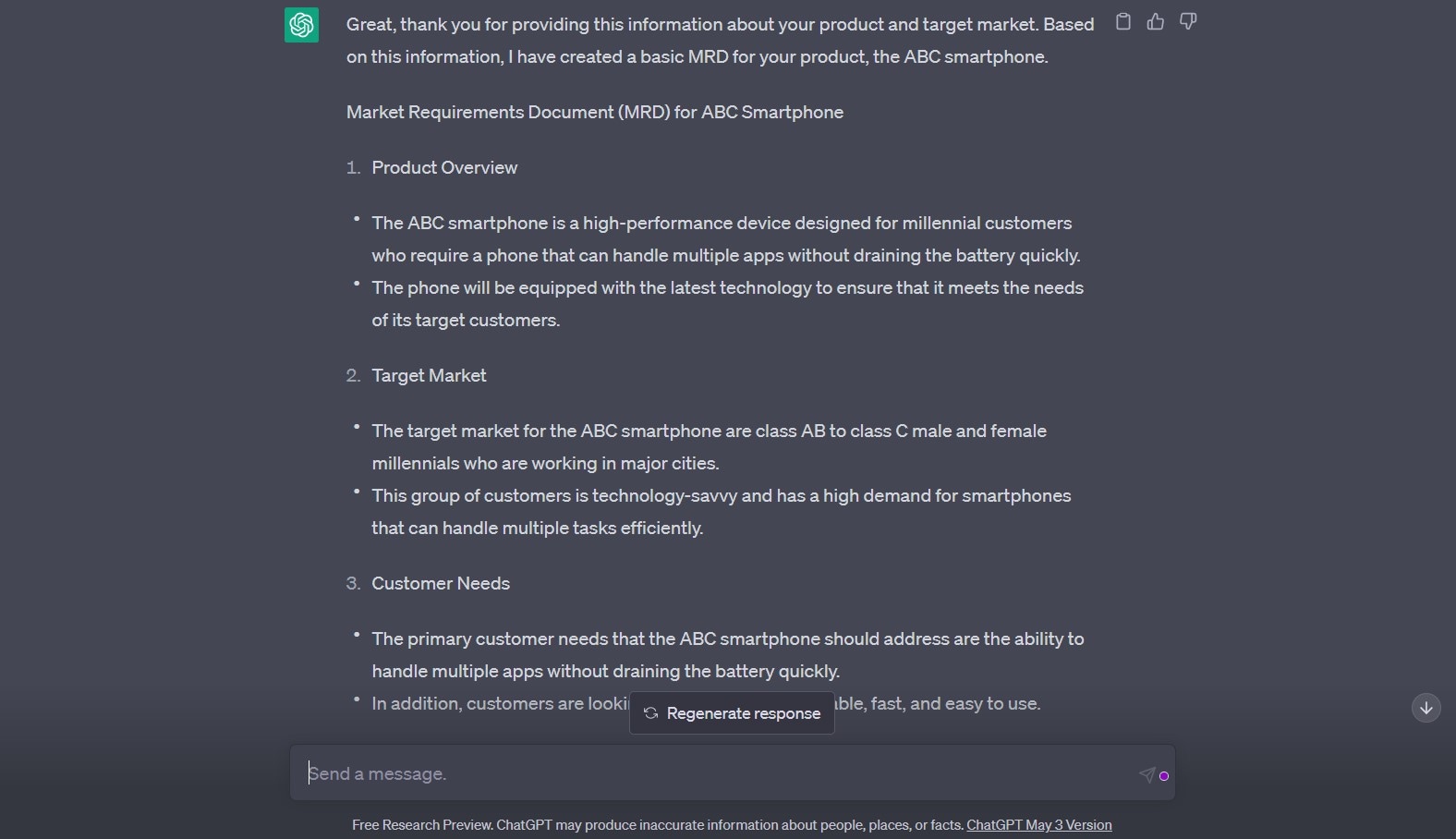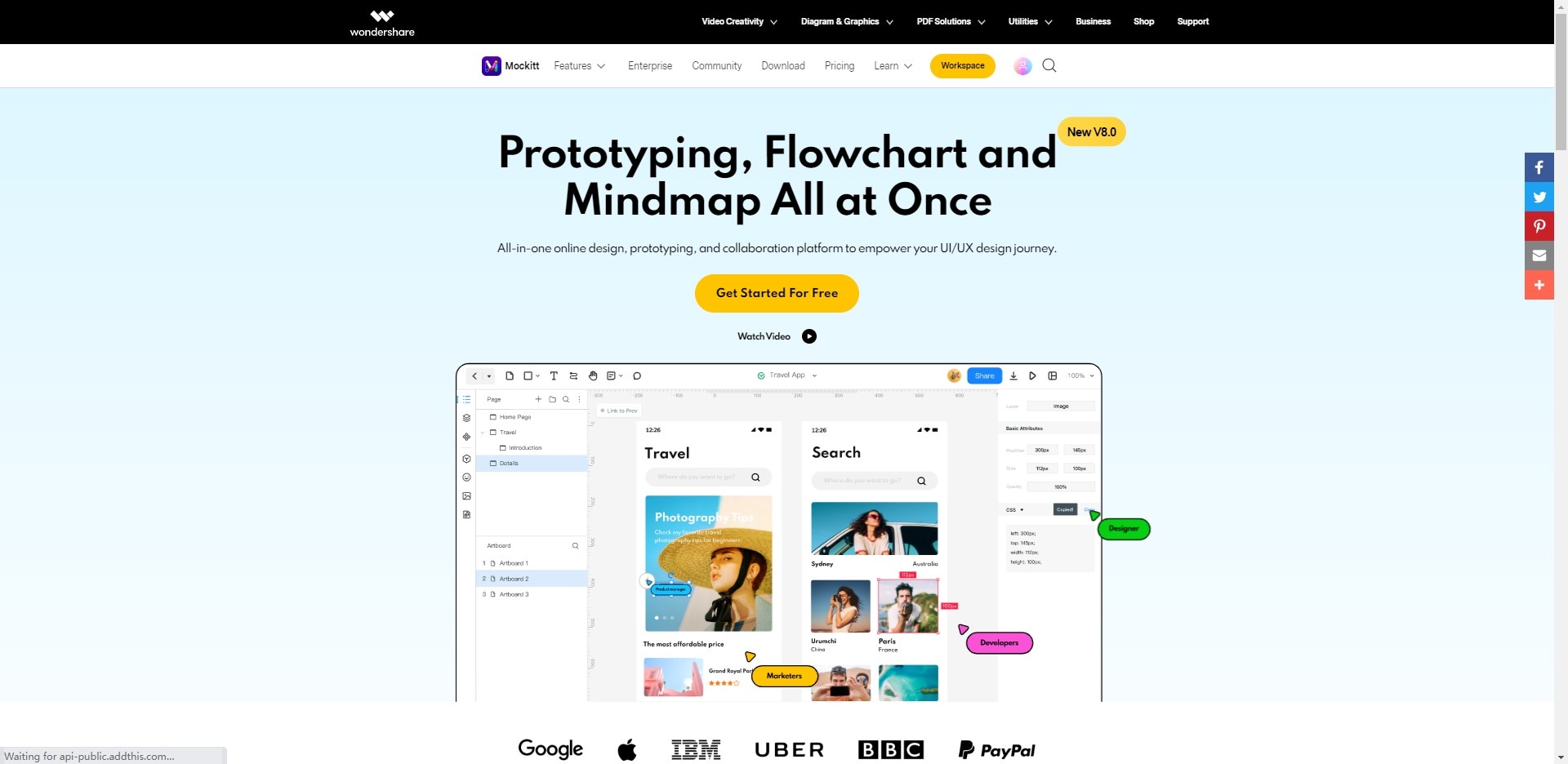How to Create a Market Requirement Document (MRD) Using ChatGPT
Introducing a product without understanding market needs can be costly for businesses. The Market Requirement Document (MRD) should be your first step. This plan captures market demands while connecting product strategy and opportunities. In short, a marketing requirements document summarizes critical insights for product development.
Advances in technology have made it easier than ever to create an MRD. ChatGPT, a language model powered by OpenAI, can make creating an MRD easy. By following the steps outlined in this article, you can ensure the success of your product. You'll also gain insights on MRD best practices while using ChatGPT to create one.
- Part 1: Overview of Market Requirement Document (MRD)
- Part 2: Market Requirement Document (MRD) vs. Product Requirements Document (PRD)
- Part 3: Steps To Create an MRD Using ChatGPT [Step By Step]
- Part 4: Best Practices for Creating MRDs With ChatGPT

A market requirement document (MRD) is a comprehensive report of market opportunities. Grounded in extensive research, it summarizes market trends, customer needs, and industry insights. Product managers are responsible for creating the MRD. But, the document should be a collaborative effort involving cross-functional teams.
Why is a Market Requirement Document Necessary?
Agile teams might use a condensed or customized version of the MRD as a starting point. Companies can simplify the process by using a market requirements document template. By using this template, the team can focus on the content of the document rather than the structure.
Here are some specific purposes for writing a marketing requirements document:
- Clear prioritization. With an MRD, you can identify potential gaps in the market that a product can fill. It helps divide limited resources better in the long run.
- Avoid duplication of efforts. Without a market requirement document, different teams can work on similar projects. The MRD ensures the team works towards a shared goal without duplicating efforts.
- Better decision-making. The MRD provides a solid foundation for drafting the product requirements document (PRD). It establishes the product capabilities needed to meet customer expectations and outperform competitors.
Primary Sections of a Marketing Requirements Document
If you want to create an MRD, a market requirements document template is the way. But before you begin, you should know what goes into the plan. A marketing requirement document includes high-level feature categories, product vision, and metrics. Keep reading to discover more about each of these parts.

- Executive Summary. It contains your key findings, assumptions, and recommendations.
- Vision. Product vision defines the long-term aspirations for the product. It outlines its purpose and value proposition.
- Target Market. It contains details like demographics and buying behaviors. The target market should also outline its size, potential growth, and relevant trends.
- Personas. It describes a fictional representation of the ideal customer for the product. Persona helps you to create more targeted and effective marketing strategies.
- Competitor Analysis. Identify and check the strengths and weaknesses of your competitors. It involves researching their marketing strategies to gain insight into their business practices.
- High-level Capabilities. These main features and functionalities should meet the target market's needs. Describe high-level capabilities without going into specific technical details.
- Metrics. Measure the product's performance against the defined objectives. The impact provides insights into areas that need improvement.
As a product manager or marketer, you're likely familiar with MRDs and PRDs. But do you know the critical differences between them? If you're wondering what sets these two documents apart, keep reading. Learn how MRD and PRD work together to drive successful product launches.
|
Marketing Requirements Document (MRD) |
Product Requirements Document (PRD) |
|
|
Purpose |
To identify and document market needs and requirements for a product |
To document the specific product functionality needed to meet the identified market needs |
|
Audience |
Typically used by product management and marketing teams |
Typically used by product development and engineering teams |
|
Contents |
Market analysis, customer requirements, product vision, revenue potential, etc. |
Wireframes, mockups, user stories, release details requirements, etc. |
|
Focus |
External market and customer needs |
Internal product development requirements |
|
Scope |
A high-level overview of the market and customer needs |
Detailed specifications of product features and functionality |
|
Timeline |
Created during the early stages of product planning |
Created after the marketing requirements document |
The MRD and PRD are both important in product development. The market requirement document sets the foundation by defining the market requirements. Meanwhile, the product requirements document translates those requirements into specific product features and designs. The MRD looks at the big picture, while the PRD focuses on details.

Think of the MRD as the "what" and the PRD as the "how". Together, they ensure that the product meets both business and customer needs. The MRD helps make sure the product is viable and meets business goals. Then, the PRD ensures product design meet customer preferences.
Part 3. Steps to Create an MRD Using ChatGPT
As an AI language model, ChatGPT itself cannot create an MRD without input from you. But, with the details you provide, like your product and target market, ChatGPT can assist you. Think of ChatGPT as a helpful assistant who can guide you through the creation process of market requirement documents.
It can provide suggestions to ensure your MRD tailors to your needs. By working with ChatGPT, you can create an MRD that sets your product on the path to success.

Benefits of Using ChatGPT To Create a Marketing Requirements Document
Let's talk about how ChatGPT can make the process easier. Imagine having an AI assistant who inspires new ideas. Well, that's what ChatGPT can do for you. With ChatGPT by your side, you'll be on your way to creating a market requirement document template that drives your business forward.
- Instant. With ChatGPT, you can create an MRD without spending hours writing. It can provide a market requirements document template, saving you time and effort.
- Content Creation. ChatGPT can assist in creating content for each section of the MRD. This feature can help cover all necessary points in your document.
- Quick Summary. ChatGPT can also help you create a fast summary of the MRD. It can highlight vital details, making it easier for the team to understand the document.
- Inspire Ideas. ChatGPT can provide suggestions that you may not have considered. It helps you create a more comprehensive and effective MRD.
How to Use ChatGPT to Generate Content for Each Section of the MRD
This AI tool can provide a complete MRD or a market requirements document template based on your specific prompts. Here's how to use this AI tool for that purpose:
Step 1: Open ChatGPT on your browser, then log in or create an account.
Step 2: Answer the following questions to provide ChatGPT with the data it needs to assist you. Enter your responses in the Send a message text field.
- What is your product or solution?
- What industry or market does your product serve?
- Who is the target customer for your product?
- What are the primary customer needs that your product should address?
- Who are your main competitors in the market?
- What are the strengths and weaknesses of your competitors?
- What are the revenue goals for your product?
Step 3: Wait as ChatGPT generates a response for you.

Note: Click Generate response below each chat answer for alternative answers.
Examples of Prompts to Follow to Create a Market Requirement Document in ChatGPT
If you're unsure what prompts to give ChatGPT to generate a marketing requirements document, here are some examples to get you started.

- Could you please create an executive summary for my MRD and include the most important details I need?
- Please generate a product vision statement for my MRD that outlines the long-term goal and purpose of the product, as well as the benefits it will provide to our target market and the company as a whole.
- Can you help me create a persona for my MRD? I need to understand my target customer's demographics, goals, pain points, and behaviors.
- Can you provide an analysis of our competitor's strengths and weaknesses in the market?
Like any other AI-powered tool, there are best practices to follow to ensure the best results. Follow these to maximize the potential of ChatGPT to capture your marketing objectives. So, let's dive into the best practices to help you start on the right foot.
1.Validate Generated Content
Ensure that the content is accurate and up-to-date using reliable sources. It's also crucial to review the generated content for errors and inconsistencies.
2.Customize Prompts
ChatGPT can provide various prompts to generate content for the marketing requirements document. However, customizing these prompts can lead to better results. For example, focusing on a particular customer segment can produce more relevant content.
Tip:
Mockitt also has a built-in AI Chat, which you can use similarly to ChatGPT. Its AI tool works like ChatGPT, allowing you to enter your prompts and receive real-time responses. The difference is it has pre-defined prompts you can use if you have no idea what prompt to ask.

However, there is a usage restriction on free users. You can use it only 30 times. Subscribe to the Professional or Enterprise plan for unlimited chats. Even so, with its AI-powered assistant, Mockitt is a valuable tool for various professionals.
3. Collaborate with Team Members
Creating a marketing requirements document (MRD) is a collaborative process involving several team members. Involve them for feedback and input on the generated content.

This is where Mockitt comes in handy. With Mockitt, you can easily create product prototypes, flowcharts to map out the user experience, and mind maps to organize your ideas.
You can collaborate with your team members and get real-time feedback during product development. This makes it easier to iterate on your design and ensure that your product meets the customer's needs and expectations.
Conclusion
Creating a marketing requirements document (MRD) is the first step in product development. And using ChatGPT can simplify the process. You can create a well-written market requirements document template by validating generated content, customizing prompts, and collaborating with team members.
Also, leveraging Mockitt, an all-in-one tool for prototyping, flowcharting, and mind mapping, can help product managers, marketers, product development teams, and your other team member with MRD and PRD. It allows you to make a prototype, collaborate with team members, and collect feedback in real-time. So, start leveraging the power of these tools to bring your product ideas to life.

